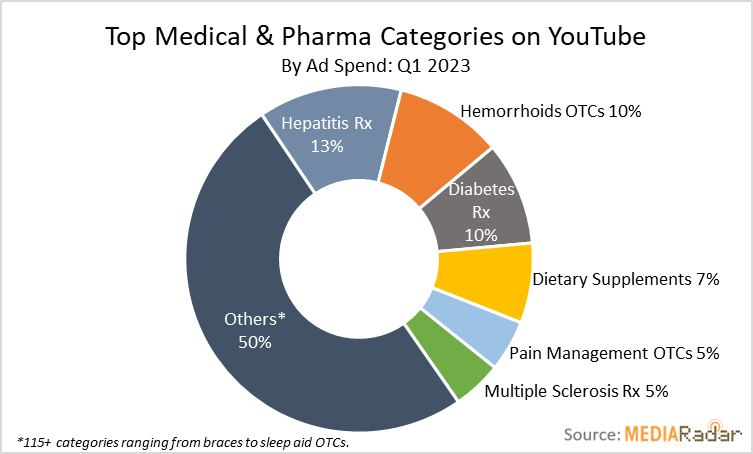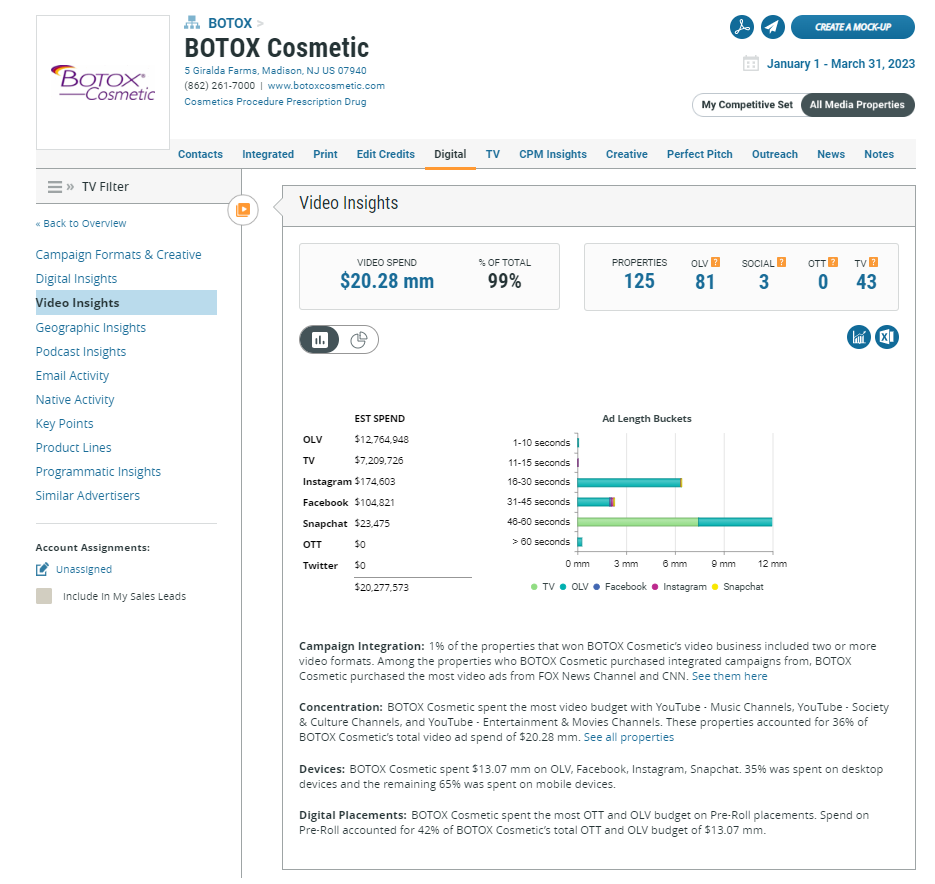YouTube’s advertising revenues topped $29b in 2022, up from about $8.1b in 2017. With 62% of American internet users accessing YouTube daily and 85% doing so weekly, advertisers big and small alike, are ready and waiting to invest in YouTube.
And some medical and pharma advertisers are sold. In Q1 2023, advertisers from big names such as AbbVie and Novo Nordisk spent more than $494mm on YouTube, representing a 26% YoY increase (up from $391mm in Q1 2022). The number of pharma and medical companies buying YouTube ads dropped by 29%.
For the advertisers who did invest in YouTube, their strategies go against their traditional MO, which could signal a greater embrace of digital advertising.

YouTube Spending Slowed by a Handful of Advertisers
In Q1 2023, half of YouTube spending from pharma and medical advertisers ($246mm) came from those promoting products in six categories: hepatitis prescriptions, hemorrhoids over-the-counter (OTC) meds, diabetes prescriptions, dietary supplements, pain management OTC meds, and multiple sclerosis prescriptions.

- Hepatitis prescriptions: ~$66mm
- Hemorrhoids OTC medications: ~$50mm
- Diabetes prescriptions: ~47mm
- Dietary supplement: ~$36mm
- Pain management OTC medications: ~$24mm.
- Multiple Sclerosis prescriptions: ~$23mm.
Despite the increase in YouTube ad spend, advertisers for dietary supplements decreased YouTube spending by 90% YoY, including Ka’Chava and Nucific.As surprising as that may seem, the strategy may have some merit. Despite dropping YouTube from its media mix, Nucific recently celebrated the milestone of selling more than 3mm units of its best-selling product, Bio-X4.
Pharma & Medical Advertisers do the Unexpected
Pharma and medical advertisers have a history of running campaigns built on a foundation of lengthy ads.
It’s a generally accepted practice that most consumers are okay with. According to a recent study, 64% of respondents thought the length of pharmaceutical ads was fair, good, or excellent.
Still, this goes against everything society craves: Nuggets of content.
The popularity of TikTok and Instagram Reels proves that.
So, when it comes to digital advertising, shorter is often better.
Pharma and medical advertisers have historically shunned that best practice, but they may be having a change of heart.
In Q1, almost 130 companies out of the total 325 invested their YouTube dollars in ads less than 15 seconds, including those promoting hemorrhoids OTC meds, diabetes prescriptions, dietary supplements, pain management OTC meds, and depression prescriptions.
Meanwhile, more than 130 and 65 companies invested in ads of 16-30 and 31-45 seconds, respectively. Advertisers for diabetes prescriptions, heart attack prevention prescriptions, and cold/cough OTCs who bought 31-45 second YouTube ads in Q1 2022 didn’t return in thus far in 2023.
Finally, just 95 companies, including Botox, invested in ads that eclipsed the one-minute mark.

The pharma and medical advertisers’ embrace of shorter ads could signal that they’re evolving to meet the preferences of today’s digital-first world. This could also open the door to more innovative and future-facing ad types, including OTT and CTV.
Where Besides YouTube?
Where else are medical and pharma big budgets going?
Unsurprisingly, traditional ad formats are still getting a lot of love.
In 2022, pharma advertisers collectively invested over 65% of their budgets in broadcast and cable ads. For these advertisers, traditional formats, namely TV, still offer impressive reach, especially among older consumers.
The continued investment in traditional ad formats also follows the recent trend of advertisers investing more in these OG formats as they prepare for the final downfall of third-party cookies, increasing digital ad loads, and dwindling trust in some digital formats.
While traditional ads will continue to get plenty of attention from pharma and medical advertisers, the industry’s accelerated shift to digital will push advertisers into the future—a push we already saw taking place in 2022.
Last year, advertisers for 572 pharma brands spent nearly $1.5b on video ads, with a handful investing only in the format, including Entyvio (Millennium Pharmaceuticals), Gardasil 9 (Merck & Co), Prevnar 20 (Pfizer), Epclusa (Gilead Sciences), and Cibinqo (Pfizer).
Social media advertising will also be more prominent as younger generations turn to Facebook, Instagram, and Twitter for healthcare information. In fact, a recent study found that 76% of people use social media after a doctor’s visit to ask others about their experiences.
Influencer marketing will likely play a role, too. According to WEGO Health, 51% of patients “mostly” or “completely” trust patient health influencers. At the same time, 85% of patients said they’d be “somewhat” or “very receptive” to an ad from a patient influencer.
YouTube Still Has a Place for Pharma and Medical Advertisers
YouTube’s reach and influence are simply too much for advertisers to ignore.
As younger healthcare professionals (HCPs) enter the workforce and consumers turn to YouTube for all of their healthcare needs, the platform will remain a key nexus between brands and their target audience.
For more insights, sign up for MediaRadar’s blog here.



